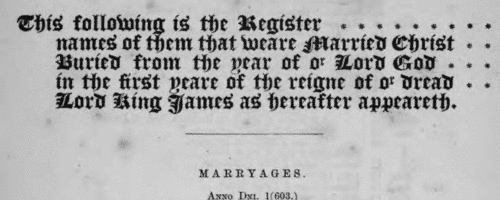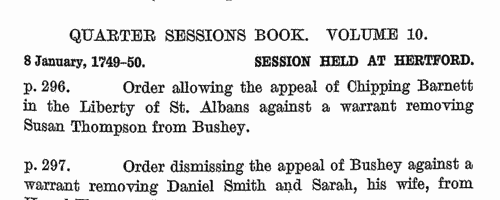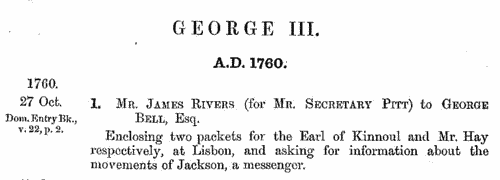Our indexes include entries for the spelling fortescue. In the period you have requested, we have the following 430 records (displaying 141 to 150):
Subscribers to the Devon & Exeter Hospital: £5 and more a year
(1748)
List of the governors and other subscribers and contributors to the Devon and Exeter Hospital for Sick and Lame Poor, before the Bishop of Exeter and the other governors. Those subscribing £5 or more per annum were standing members of the committee, by virtue of their subscriptions; those subscribing £2 or more a year were thereby governors; those marked with a star were in 1748 the present members of the elective part of the committee. There were also fourteen governors by virtue of their past benefactions, ranging from £20 to £123 8s. | Sample scan, click to enlarge

|
Burials at the Rolls Chapel (1749)
The Rolls Chapel in Chancery Lane was both a repository for the Chancery records and also the burial place of Masters of the Rolls, many of whose monuments adorned the building. The chapel was also used occasionally for weddings.
| Sample scan, click to enlarge

|
Wandsworth Burials
(1750)
The ancient parish of Wandsworth in Surrey comprised the single township of Wandsworth, including the hamlets of Garratt, Half Farthing and Summers Town. It lay in the archdeaconry of Surrey of the diocese of Winchester: unfortunately, few bishop's transcripts of Surrey parish registers survive earlier than 1800. Although the original parish registers of Wandsworth doubtless commenced in 1538, the volume(s) before 1603 had been lost by the 19th century. In 1889 a careful transcript by John Traviss Squire of the first three surviving registers was printed, and we have now indexed it year by year. The early burial registers contain little detail - date of burial, and full name. For the burial of children, the father's name is also stated; for the burial of wives, the husband's. Such details as date or cause of death, age, address or occupation are almost never given. The burial registers are considerably more bulky than the baptism registers, because the burying ground was used by Dissenters, who formed a large part of the population. These include a French Protestant congregation that worshipped in a church (the registers of which do not survive) in a courtyard immediately opposite the parish church. The Quakers had a cemetery of their own. The 18th-century burial registers also include a surprising number of children sent out to Wandsworth from London to nurse. | Sample scan, click to enlarge

|
Hertfordshire Sessions
(1700-1752)
Incidents from the Hertfordshire Sessions Books and Minute Books. These cover a wide range of criminal and civil business for the county: numerically, the the most cases (240) concerned assaults; presentments about repairs to roads and bridges (67); larceny (63); unlicensed and disorderly alehouses (33); nuisances (28); and trading without due apprenticeship (24). This calendar gives abstracts of all entries in the Sessions Books and Minute Books for Hertfordshire sessions for the period. | Sample scan, click to enlarge

|
 Apprentices registered in Northamptonshire and Warwickshire
(1750-1754) Apprentices registered in Northamptonshire and Warwickshire
(1750-1754)
Apprenticeship indentures and clerks' articles were subject to a 6d or 12d per pound stamp duty: the registers of the payments usually give the master's trade, address, and occupation, and the apprentice's father's name and address, as well as details of the date and length of the apprenticeship. There are central registers for collections of the stamp duty in London, as well as returns from collectors in the provinces. These collectors generally received duty just from their own county, but sometimes from further afield. (The sample entry shown on this scan is taken from a Norfolk return) | Sample scan, click to enlarge

|
 Apprentices registered in Plymouth
(1760) Apprentices registered in Plymouth
(1760)
Apprenticeship indentures and clerks' articles were subject to a 6d or 12d per pound stamp duty: the registers of the payments usually give the master's trade, address, and occupation, and the apprentice's name, as well as details of the date and length of the apprenticeship. There are central registers for collections of the stamp duty in London, as well as returns from collectors in the provinces. These collectors generally received duty just from their own county, but sometimes from further afield. The indentures themselves can date from a year or two earlier than this return. (The sample entry shown on this scan is taken from a Bristol return. Each entry has two scans, the other being the facing page with the details of the indenture, length of service, and payment of duty.) IR 1/54 | Sample scan, click to enlarge

|
Royal officials &c in Ireland
(1760-1761)
This calendar of Home Office papers was edited by Joseph Redington and published in 1878. The period covered by this index is from the accession of king George III, 25 October 1760, to 31 December 1761. The documents abstracted were a part of the great archive called the State Papers Domestic, and comprised letters to and from the Secretaries of State, and other letters; reports; memorials and petitions; and warrants of various kinds. Some repetitive material was reduced into tables. We have teased out this diverse and heterogeneous material into separate indexes for each subject. | Sample scan, click to enlarge

|
 Apprentices and trainee clerks
(1763) Apprentices and trainee clerks
(1763)
Apprenticeship indentures and clerks' articles were subject to a 6d or 12d per pound stamp duty (late payment of the 6d rate attracted double duty (D D) of 12d): the registers of the payments usually give the master's trade, address, and occupation, and the apprentice's name, as well as details of the date and length of the apprenticeship. 1 January to 9 December 1763. | Sample scan, click to enlarge

|
 Masters of clerks and apprentices
(1764) Masters of clerks and apprentices
(1764)
Apprenticeship indentures and clerks' articles were subject to a 6d or 12d per pound stamp duty (late payment of the 6d rate attracted double duty (D D) of 12d): the registers of the payments usually give the master's trade, address, and occupation, and the apprentice's name, as well as details of the date and length of the apprenticeship. 2 January to 31 December 1764. | Sample scan, click to enlarge

|
 Masters of clerks and apprentices
(1765) Masters of clerks and apprentices
(1765)
Apprenticeship indentures and clerks' articles were subject to a 6d or 12d per pound stamp duty (late payment of the 6d rate attracted double duty (D D) of 12d): the registers of the payments usually give the master's trade, address, and occupation, and the apprentice's name, as well as details of the date and length of the apprenticeship. 2 January to 31 December 1765. | Sample scan, click to enlarge

|
Research your ancestry, family history, genealogy and one-name study by direct access to original records and archives indexed by surname.












